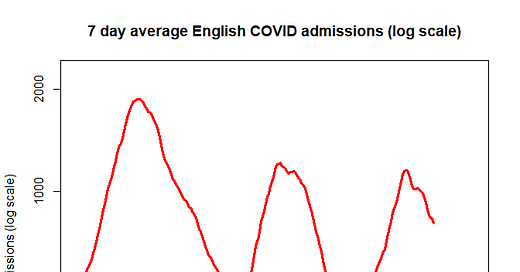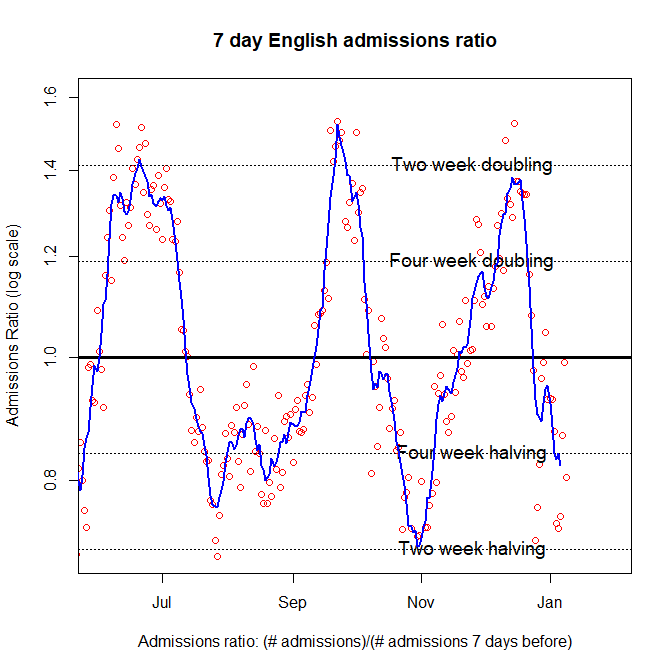(9.10am, 12/1/23) I’m too busy at the moment for anything other than these weekly COVID updates - sorry about that! Final book editing, a huge stack of exam marking, multiple job interview panels and a couple of research workshops are keeping me busy now and for the next two weeks. I did have time to talk to Andrew Orlowski at the Telegraph for his punchy piece about the value of maths and of a numerate population though.
You might have also noticed I’m having a temporary Twitter hiatus, which is something I do when I need to focus without distractions. But I have to say that between Elon Musk’s decision to hand privileged access to a notorious antivaxxer on one hand, and getting the usual grief from Zero COVIDers on the other, it was a really easy decision this time. I expect I’ll be back there if and when work calms down though, I’m only human.
In the meantime, please consider signal-boosting this Substack and subscribing if you didn’t already, because I think there are a lot of bad COVID takes out there at the moment (from both extremes of the argument) and I promise to do my best to mail out better ones to subscribers whenever I can.
Anyway, onto the week’s COVID data. Last week, we’d seen a tentative drop in admissions numbers in the New Year (there was a big ONS jump, but that pre-dated Christmas, and XBB.1.5 on the horizon, but not in big enough numbers to be influencing the trends yet). This was all pretty much as I’d predicted on 22nd December, though of course I am mindful of confirmation bias:
Hopefully Christmas and reduced mixing in the New Year will reverse these trends though
It seems like the picture is really more of the same this week. ZOE has continued to fall nationally. Last week ZOE estimated incidence was 217k, this week it is 170k (a fall of 22% in a week - in fact 170k was yesterday’s figure, so this is strictly 22% in six days). To put it in context, this is a fall of just over a third from the peak values of 263k that ZOE was giving around Twixtmas. (10am 14/1/23 update: In fact ZOE incidence seems to be going off a cliff at the moment - the latest figure is 137k - which is obviously very welcome news)
However, watch out for alarmist takes from people posting steeply climbing local ZOE graphs. Feel free to ask them whether they post when the numbers fall, to give examples where local spikes have converted into admissions spikes lately, or to explain how growth could be so localised in a population which is moving around more or less as normal these days! I think it’s a classic case of reporting bias - ZOE gives you a graph of where you live, if it’s spiking up you are much more likely to post it than if it is flat. But ultimately I’m not convinced how much signal there is in these local estimates anyway because of small sample sizes - see this classic xkcd cartoon!
XBB.1.5 continues to nudge up its market share in the UK, but was still in single-figure percentages in the first week of the year, according to Dave’s invaluable variant-tracking page. It’s got a decent enough growth advantage to cause some kind of uptick in a few weeks I think, but I’m still not convinced it’s the end of the world or deserves a stupid name.
All this then feeds into the most important thing, namely the admissions data. Obviously the NHS is under extreme pressure at the moment, and COVID is only one part of this picture, so any reduction in numbers doesn’t mean that things are magically transformed overall. However, a drop is a drop, and this week has seen a pretty decent drop - the seven-day average is now down to 808.
In terms of the admissions ratio, it looks to be around four week halving for now.
(4pm 12/1/23) Case data reported - the case ratios are all a bit noisy still, because this week we are still comparing with the week across New Year, when figures were distorted. But it seems clear that overall there is a drop of reasonable magnitude here too, and next week should be better in judging what the current rate of fall settles down to.
(Midday, 13/1/23) Consistent with this, we can see a small but noticeable fall on this week’s ONS (which refers to week ending 3rd January), confirming the impression from all other sources that we have peaked and are falling.







